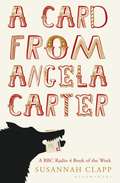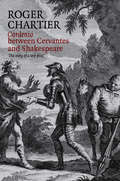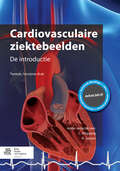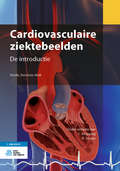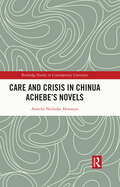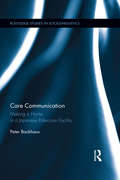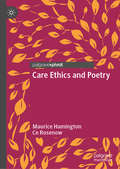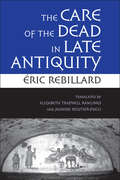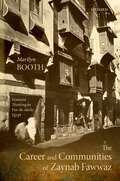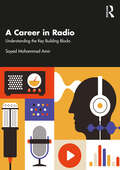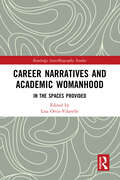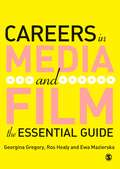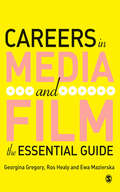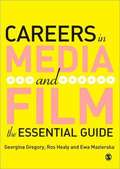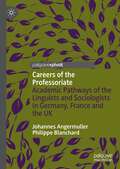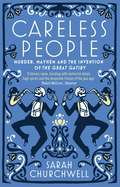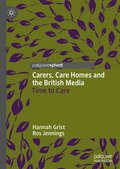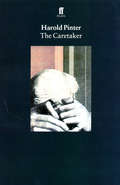- Table View
- List View
A Card From Angela Carter
by Susannah ClappAngela Carter was one of the most vivid voices of the twentieth century. When she died in 1992 at the age of fifty-one, she had published fifteen books of fiction and essays; outrage at her omission from any Booker Prize shortlists led to the foundation of the Orange Prize.Angela Carter sent her friend Susannah Clapp postcards from all over the world, missives which form a paper trail through her life. The pictures she chose were sometimes domestic, sometimes flights of fantasy and surrealism. The messages were always pungent.Here, Susannah Clapp uses postcards – the emails of the twentieth century – to travel through Angela Carter's life, and to evoke her anarchic intelligence, fierce politics, rich language and ribaldry, and the great swoops of her imagination.
Cardenio between Cervantes and Shakespeare: The Story of a Lost Play
by Roger ChartierHow should we read a text that does not exist, or present a play the manuscript of which is lost and the identity of whose author cannot be established for certain? Such is the enigma posed by Cardenio – a play performed in England for the first time in 1612 or 1613 and attributed forty years later to Shakespeare (and Fletcher). Its plot is that of a ‘novella’ inserted into Don Quixote, a work that circulated throughout the major countries of Europe, where it was translated and adapted for the theatre. In England, Cervantes’ novel was known and cited even before it was translated in 1612 and had inspired Cardenio. But there is more at stake in this enigma. This was a time when, thanks mainly to the invention of the printing press, there was a proliferation of discourses. There was often a reaction when it was feared that this proliferation would become excessive, and many writings were weeded out. Not all were destined to survive, in particular plays for the theatre, which, in many cases, were never published. This genre, situated at the bottom of the literary hierarchy, was well suited to the existence of ephemeral works. However, if an author became famous, the desire for an archive of his works prompted the invention of textual relics, the restoration of remainders ruined by the passing of time or, in order to fill in the gaps, in some cases, even the fabrication of forgeries. Such was the fate of Cardenio in the eighteenth century. Retracing the history of this play therefore leads one to wonder about the status, in the past, of works today judged to be canonical. In this book the reader will rediscover the malleability of texts, transformed as they were by translations and adaptations, their migrations from one genre to another, and their changing meanings constructed by their various publics. Thanks to Roger Chartier’s forensic skills, fresh light is cast upon the mystery of a play lacking a text but not an author.
Cardenio between Cervantes and Shakespeare: The Story of a Lost Play
by Roger ChartierHow should we read a text that does not exist, or present a play the manuscript of which is lost and the identity of whose author cannot be established for certain? Such is the enigma posed by Cardenio – a play performed in England for the first time in 1612 or 1613 and attributed forty years later to Shakespeare (and Fletcher). Its plot is that of a ‘novella’ inserted into Don Quixote, a work that circulated throughout the major countries of Europe, where it was translated and adapted for the theatre. In England, Cervantes’ novel was known and cited even before it was translated in 1612 and had inspired Cardenio. But there is more at stake in this enigma. This was a time when, thanks mainly to the invention of the printing press, there was a proliferation of discourses. There was often a reaction when it was feared that this proliferation would become excessive, and many writings were weeded out. Not all were destined to survive, in particular plays for the theatre, which, in many cases, were never published. This genre, situated at the bottom of the literary hierarchy, was well suited to the existence of ephemeral works. However, if an author became famous, the desire for an archive of his works prompted the invention of textual relics, the restoration of remainders ruined by the passing of time or, in order to fill in the gaps, in some cases, even the fabrication of forgeries. Such was the fate of Cardenio in the eighteenth century. Retracing the history of this play therefore leads one to wonder about the status, in the past, of works today judged to be canonical. In this book the reader will rediscover the malleability of texts, transformed as they were by translations and adaptations, their migrations from one genre to another, and their changing meanings constructed by their various publics. Thanks to Roger Chartier’s forensic skills, fresh light is cast upon the mystery of a play lacking a text but not an author.
Cardiovasculaire ziektebeelden: De introductie
by C. Klöpping and R. JansenCardiovasculaire ziektebeelden biedt de basiskennis die nodig is voor verdieping van het vakgebied hart- en vaatziekten. De aandacht ligt in dit boek vooral op de klinische aspecten van cardiovasculaire ziekten. Het boek is opgedeeld in verschillende hoofdthema’s trombose en atherosclerose, ischemische hartziekten, ritmestoornissen, hartfalen, hartklepafwijkingen en lichamelijk onderzoek bij hartziekten. De onderwerpen worden overzichtelijk en beknopt behandeld. Daarmee is het een handig naslagwerk dat kan worden gebruikt in de dagelijkse praktijk van zowel de studenten geneeskunde als de coassistent. Het boek is geschikt voor alle studenten geneeskunde in Nederland die bij het bestuderen van cardiovasculaire ziektebeelden tijdens hun opleiding tot arts behoefte hebben aan een Nederlandstalig basisboek. Tijdens coassistentschappen of semi-arts-stages is het een handig naslagwerk dat gemakkelijk in ‘de witte jas’ kan worden meegedragen. Verder is het een toegankelijk boek voor arts-assistenten in opleiding tot internist of een deelspecialisme hiervan, physician assistants in opleiding en verpleegkundigen.
Cardiovasculaire ziektebeelden: De introductie
by C. Klöpping R. JansenCardiovasculaire ziektebeelden biedt de basiskennis die nodig is voor verdieping van het vakgebied hart- en vaatziekten. De aandacht ligt in dit boek vooral op de klinische aspecten van cardiovasculaire ziekten. Het boek is opgedeeld in verschillende hoofdthema’s trombose en atherosclerose, ischemische hartziekten, ritmestoornissen, hartfalen, hartklepafwijkingen en lichamelijk onderzoek bij hartziekten. De onderwerpen worden overzichtelijk en beknopt behandeld. Daarmee is het een handig naslagwerk dat kan worden gebruikt in de dagelijkse praktijk van zowel de studenten geneeskunde als de coassistent. Het boek is geschikt voor alle studenten geneeskunde in Nederland die bij het bestuderen van cardiovasculaire ziektebeelden tijdens hun opleiding tot arts behoefte hebben aan een Nederlandstalig basisboek. Tijdens coassistentschappen of semi-arts-stages is het een handig naslagwerk dat gemakkelijk in ‘de witte jas’ kan worden meegedragen. Verder is het een toegankelijk boek voor arts-assistenten in opleiding tot internist of een deelspecialisme hiervan, physician assistants in opleiding en verpleegkundigen.
Care and Crisis in Chinua Achebe's Novels (Routledge Studies in Contemporary Literature)
by Amechi Nicholas AkwanyaThis book is a new study of Chinua Achebe’s novels in which they are read as works of literary art, as literary works are studied and discussed within the discipline of literary studies and criticism. A central concept, care, which is a humane value, is found to run in the texts, and is the crux of the test that the major characters are subjected to. What challenges them as things to be taken care of through concern may be a human being in a dire circumstance, as with Ikemefuna (Things Fall Apart), the human group itself exposed to famine in what should be harvest time (Arrow of God), or the state which needs to be brought to its proper being, as Heidegger would say (No Longer at Ease and A Man of the People), or human suffering calling to be relieved (Anthills of the Savannah). The novels are all in the tragic mode, because intervention is under some kind of interdiction.
Care and Crisis in Chinua Achebe's Novels (Routledge Studies in Contemporary Literature)
by Amechi Nicholas AkwanyaThis book is a new study of Chinua Achebe’s novels in which they are read as works of literary art, as literary works are studied and discussed within the discipline of literary studies and criticism. A central concept, care, which is a humane value, is found to run in the texts, and is the crux of the test that the major characters are subjected to. What challenges them as things to be taken care of through concern may be a human being in a dire circumstance, as with Ikemefuna (Things Fall Apart), the human group itself exposed to famine in what should be harvest time (Arrow of God), or the state which needs to be brought to its proper being, as Heidegger would say (No Longer at Ease and A Man of the People), or human suffering calling to be relieved (Anthills of the Savannah). The novels are all in the tragic mode, because intervention is under some kind of interdiction.
Care Communication: Making a home in a Japanese eldercare facility (Routledge Studies in Sociolinguistics)
by Peter BackhausThis book studies communication in institutional eldercare. It is based on audio-recorded interactions between residents and staff in a Japanese care facility. The focus is on the morning care routines, which include getting the residents out of bed and ready for the day. Combining quantitative and qualitative methods, the analysis explores the characteristics of care communication as they become manifest in the interactional small print. Topics include the use of terms of address and formal speech, the basic organisation of openings and closings, the difficulties of talking while working—and, at times, working while talking—and tempo differences between residents and staff as they move along between bed and breakfast. The research findings are contextualised with results from previous studies, tracing significant features and explanation for deviant cases. The author is a trained linguist and certified nursing assistant with first-hand working experience in institutional eldercare.
Care Communication: Making a home in a Japanese eldercare facility (Routledge Studies in Sociolinguistics)
by Peter BackhausThis book studies communication in institutional eldercare. It is based on audio-recorded interactions between residents and staff in a Japanese care facility. The focus is on the morning care routines, which include getting the residents out of bed and ready for the day. Combining quantitative and qualitative methods, the analysis explores the characteristics of care communication as they become manifest in the interactional small print. Topics include the use of terms of address and formal speech, the basic organisation of openings and closings, the difficulties of talking while working—and, at times, working while talking—and tempo differences between residents and staff as they move along between bed and breakfast. The research findings are contextualised with results from previous studies, tracing significant features and explanation for deviant cases. The author is a trained linguist and certified nursing assistant with first-hand working experience in institutional eldercare.
Care Ethics and Poetry
by Maurice Hamington Ce RosenowCare Ethics and Poetry is the first book to address the relationship between poetry and feminist care ethics. The authors argue that morality, and more specifically, moral progress, is a product of inquiry, imagination, and confronting new experiences. Engaging poetry, therefore, can contribute to the habits necessary for a robust moral life—specifically, caring. Each chapter offers poems that can provoke considerations of moral relations without explicitly moralizing. The book contributes to valorizing poetry and aesthetic experience as much as it does to reassessing how we think about care ethics.
The Care of the Dead in Late Antiquity (Cornell Studies in Classical Philology #59)
by Éric RebillardIn this provocative book Éric Rebillard challenges many long-held assumptions about early Christian burial customs. For decades scholars of early Christianity have argued that the Church owned and operated burial grounds for Christians as early as the third century. Through a careful reading of primary sources including legal codes, theological works, epigraphical inscriptions, and sermons, Rebillard shows that there is little evidence to suggest that Christians occupied exclusive or isolated burial grounds in this early period. In fact, as late as the fourth and fifth centuries the Church did not impose on the faithful specific rituals for laying the dead to rest. In the preparation of Christians for burial, it was usually next of kin and not representatives of the Church who were responsible for what form of rite would be celebrated, and evidence from inscriptions and tombstones shows that for the most part Christians didn't separate themselves from non-Christians when burying their dead. According to Rebillard it would not be until the early Middle Ages that the Church gained control over burial practices and that "Christian cemeteries" became common.In this translation of Religion et Sépulture: L'église, les vivants et les morts dans l'Antiquité tardive, Rebillard fundamentally changes our understanding of early Christianity. The Care of the Dead in Late Antiquity will force scholars of the period to rethink their assumptions about early Christians as separate from their pagan contemporaries in daily life and ritual practice.
The Career and Communities of Zaynab Fawwaz: Feminist Thinking in Fin-de-siècle Egypt
by Marilyn BoothZaynab Fawwaz (d. 1914) emerged from an obscure childhood in the Shi'I community of Jabal 'Amil (now Lebanon) to become a recognized writer on women's and girls' aspirations and rights in 1890s Egypt. This book insists on the centrality of gender as a marker of social difference to the Arabic knowledge movement then, or Nahda. Fawwaz published essays and engaged in debates in the Egyptian and Ottoman-Arabic press, published two novels, and the first play known to have been composed in Arabic by a female writer. This book assesses her unusual life history and political engagements—including her work late in life as an informant for the Egyptian khedive. A series of thematically focused chapters takes up her views on social justice, marriage, divorce and polygyny, the 'gender-nature' debate in the context of local understandings of Darwinism, education, and imperialism and Islamophobia, attending also to works by those to whom Fawwaz was responding. Her role in the first Arabic women's magazine, and her contributions to later women's magazines, are part of the story, too. Further chapters consider her uses of history in fiction to criticize patriarchal control of young women's lives, and her play as an intervention into reformist theatre, and the question of women's access to public culture in 1890s Egypt. Questions of desirable masculinities are central to all of these. Fawwaz was also known for her massive biographical dictionary of world women. In that work as in her essays, Fawwaz articulated an ethics of social belonging and sociality predicated on Islamic precepts of gender justice, and critical of the ways male intellectuals had used 'tradition' to silence women and deny their aspirations.
The Career and Communities of Zaynab Fawwaz: Feminist Thinking in Fin-de-siècle Egypt
by Marilyn BoothZaynab Fawwaz (d. 1914) emerged from an obscure childhood in the Shi'I community of Jabal 'Amil (now Lebanon) to become a recognized writer on women's and girls' aspirations and rights in 1890s Egypt. This book insists on the centrality of gender as a marker of social difference to the Arabic knowledge movement then, or Nahda. Fawwaz published essays and engaged in debates in the Egyptian and Ottoman-Arabic press, published two novels, and the first play known to have been composed in Arabic by a female writer. This book assesses her unusual life history and political engagements—including her work late in life as an informant for the Egyptian khedive. A series of thematically focused chapters takes up her views on social justice, marriage, divorce and polygyny, the 'gender-nature' debate in the context of local understandings of Darwinism, education, and imperialism and Islamophobia, attending also to works by those to whom Fawwaz was responding. Her role in the first Arabic women's magazine, and her contributions to later women's magazines, are part of the story, too. Further chapters consider her uses of history in fiction to criticize patriarchal control of young women's lives, and her play as an intervention into reformist theatre, and the question of women's access to public culture in 1890s Egypt. Questions of desirable masculinities are central to all of these. Fawwaz was also known for her massive biographical dictionary of world women. In that work as in her essays, Fawwaz articulated an ethics of social belonging and sociality predicated on Islamic precepts of gender justice, and critical of the ways male intellectuals had used 'tradition' to silence women and deny their aspirations.
A Career in Radio: Understanding the Key Building Blocks
by Sayed Mohammad AmirThis book gives an overview of the development, significance, and impact of radio as a medium of mass communication in modern society. It provides a thorough understanding of the various wings and functionaries of the radio industry. The book also covers aspects of commercial radio, the basics of understanding the pulse of radio listeners, formatting radio programming, making an effective sales pitch and producing great commercials to exhaustive advice on presenting a show, appearing for interviews, and public speaking. It also gives insight into the changes brought in by technology in terms of traditional radio broadcasts, such as digital radio, highlighting its advancements in audio quality and the diversity of programming options available, and satellite radio, subscription-based services, and exclusive access to specialised programming. An outcome of the author’s vast experience of working as a radio jockey and programme manager for over 17 years, his book will be an ideal textbook for undergraduate and postgraduate students of journalism and mass communication, taking courses on radio, audio and podcasting, media production and digital media. Additionally, this book will be an invaluable companion to existing radio professionals as a resource-book for their professional development.
A Career in Radio: Understanding the Key Building Blocks
by Sayed Mohammad AmirThis book gives an overview of the development, significance, and impact of radio as a medium of mass communication in modern society. It provides a thorough understanding of the various wings and functionaries of the radio industry. The book also covers aspects of commercial radio, the basics of understanding the pulse of radio listeners, formatting radio programming, making an effective sales pitch and producing great commercials to exhaustive advice on presenting a show, appearing for interviews, and public speaking. It also gives insight into the changes brought in by technology in terms of traditional radio broadcasts, such as digital radio, highlighting its advancements in audio quality and the diversity of programming options available, and satellite radio, subscription-based services, and exclusive access to specialised programming. An outcome of the author’s vast experience of working as a radio jockey and programme manager for over 17 years, his book will be an ideal textbook for undergraduate and postgraduate students of journalism and mass communication, taking courses on radio, audio and podcasting, media production and digital media. Additionally, this book will be an invaluable companion to existing radio professionals as a resource-book for their professional development.
Career Narratives and Academic Womanhood: In the Spaces Provided (Routledge Auto/Biography Studies)
by Lisa Ortiz-VilarelleCareer Narratives and Academic Womanhood is a collection of essays in which life writing scholars theorize their early-career, mid-career, and late-career experiences with the documents that shape their professional lives as women: the institutional auto/biography of employment letters, curriculum vitae, tenure portfolios, promotion applications, publication and conference bios, academic website profiles, and other self-authored narratives required by institutions to compete for opportunities and resources. The essays explore the privacy laws, peer review, disciplinary standards, digital media, and other standardizing tools, practices and policies that impact women’s self-construction at pivotal junctures at which they promote themselves in the spaces of academic careers.
Career Narratives and Academic Womanhood: In the Spaces Provided (Routledge Auto/Biography Studies)
Career Narratives and Academic Womanhood is a collection of essays in which life writing scholars theorize their early-career, mid-career, and late-career experiences with the documents that shape their professional lives as women: the institutional auto/biography of employment letters, curriculum vitae, tenure portfolios, promotion applications, publication and conference bios, academic website profiles, and other self-authored narratives required by institutions to compete for opportunities and resources. The essays explore the privacy laws, peer review, disciplinary standards, digital media, and other standardizing tools, practices and policies that impact women’s self-construction at pivotal junctures at which they promote themselves in the spaces of academic careers.
Careers in Media and Film: The Essential Guide
by Georgina Gregory Ewa Mazierksa Ros J HealyWritten for students, graduates and academics from the disciplines of film, media and related subjects, and for those from other disciplines who want to break into the media, this book is a virtual career coach and an employability course all in one package. A practical handbook, it offers encouragement, advice, information and case studies to help students to make the most of the opportunities in this very competitive career world. The book can be used as a textual support for careers modules and PDP (Personal Development Planning), graduate workshops, on-line courses and as a departmental or careers library resource. Equally, it works effectively as a self-help guide to enable individuals to focus on their career / life development.
Careers in Media and Film: The Essential Guide
by Georgina Gregory Ewa Mazierksa Ros J HealyWritten for students, graduates and academics from the disciplines of film, media and related subjects, and for those from other disciplines who want to break into the media, this book is a virtual career coach and an employability course all in one package. A practical handbook, it offers encouragement, advice, information and case studies to help students to make the most of the opportunities in this very competitive career world. The book can be used as a textual support for careers modules and PDP (Personal Development Planning), graduate workshops, on-line courses and as a departmental or careers library resource. Equally, it works effectively as a self-help guide to enable individuals to focus on their career / life development.
Careers in Media and Film: The Essential Guide
by Ewa Mazierksa Georgina Gregory Ros J HealyWritten for students, graduates and academics from the disciplines of film, media and related subjects, and for those from other disciplines who want to break into the media, this book is a virtual career coach and an employability course all in one package. A practical handbook, it offers encouragement, advice, information and case studies to help students to make the most of the opportunities in this very competitive career world. The book can be used as a textual support for careers modules and PDP (Personal Development Planning), graduate workshops, on-line courses and as a departmental or careers library resource. Equally, it works effectively as a self-help guide to enable individuals to focus on their career / life development.
Careers in Media and Film: The Essential Guide (PDF)
by Ewa Mazierksa Georgina Gregory Ros J HealyWritten for students, graduates and academics from the disciplines of film, media and related subjects, and for those from other disciplines who want to break into the media, this book is a virtual career coach and an employability course all in one package. A practical handbook, it offers encouragement, advice, information and case studies to help students to make the most of the opportunities in this very competitive career world. The book can be used as a textual support for careers modules and PDP (Personal Development Planning), graduate workshops, on-line courses and as a departmental or careers library resource. Equally, it works effectively as a self-help guide to enable individuals to focus on their career / life development.
Careers of the Professoriate: Academic Pathways of the Linguists and Sociologists in Germany, France and the UK
by Johannes Angermuller Philippe BlanchardThis book examines career patterns of the professoriate. Professors may appear as specialised individualists in their fields, and yet they follow pathways which are anything but unique. Drawing from a unique data set, the authors analyse the trajectories of the almost 2000 linguists and sociologists who hold full professorships in Germany, France and the UK in 2015. With a background in social theory, they reveal models, structures and rules that organise the professional lives and biographies of the most senior academics. This book presents the results of a systematic empirical study, which will be of interest to specialists in higher education studies as well as to linguists and sociologists, and to all academics more generally.
Careless People: Murder, Mayhem and the Invention of The Great Gatsby
by Sarah ChurchwellEbook edition includes full text of The Great Gatsby by F. Scott Fitzgerald.Since its publication in 1925, The Great Gatsby has become one of the world's best-loved books. Careless People tells the true story behind F. Scott Fitzgerald's masterpiece, exploring in newly rich detail its relation to the extravagant, scandalous, and chaotic world in which the author lived.With wit and insight, Sarah Churchwell traces the genesis of a masterpiece, mapping where fiction comes from, and how it takes shape in the mind of a genius. Careless People tells the extraordinary tale of how F. Scott Fitzgerald created a classic and in the process discovered modern America.
Carers, Care Homes and the British Media: Time to Care
by Hannah Grist Ros JenningsThis book focuses on the relationship between the media and those who work as paid care assistants in care homes in Britain. It explores this relationship in terms of the contemporary cultural and personal understandings of care work and care homes that have developed as the role has emerged as increasingly socially and economically significant in society. Three strands of analysis are integrated: an examination of the representations of paid care workers in the British media; the experiences of current and former care workers; and the autoethnographic reflections of the authors who have experiences of working as care assistants. The book offers a rich contextual and experiential account of the responsibilities, challenges, and emotions of care work in British society. Grist and Jennings make a case for the need to better value and more accurately represent care work in contemporary media accounts.
The Caretaker: Two Plays (Longman Literature Guides)
by Harold PinterIt was with this play that Harold Pinter had his first major success, and its production history since it was first performed in 1960 has established the work as a landmark in twentieth-century drama.The obsessive caretaker, Davies, whose papers are in Sidcup, is a classic comic creation, and his uneasy relationship with the enigmatic Aston and Mick established the author's individuality with an international audience.
